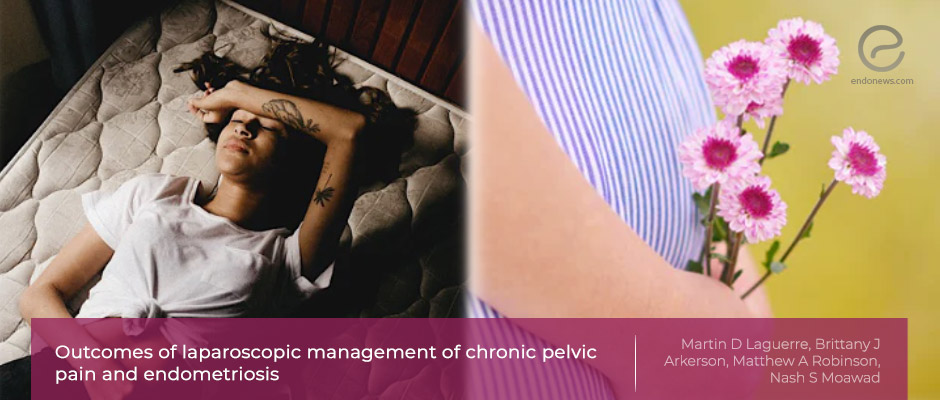Outcomes of chronic pelvic pain of endometriosis after laparoscopic surgery
Jul 23, 2021
Laparoscopic endometriosis management is effective with low re-operation rates and high efficacy in infertility caused by endometriosis.
Key Points
Highlights:
- Laparoscopic surgical management of endometriosis is effective with low re-operation rates and significant improvement across all quality of life measures including sexual discomfort, physical activities, and emotional well-being, with a high efficacy in infertility caused by endometriosis.
Importance:
- Lparoscopic surgery for pelvic pain associated with endometriosis results in low rates of reoperation and has high efficacy in treating endometriosis infertility.
What's done here:
- This retrospective cohort study includes 69 patients who underwent laparoscopic surgery due to pelvic pain at the University of Florida, Health Shands Hospital.
- Laguerre et al. aimed to evaluate the reoperation rate and quality of life after laparoscopic surgery via a prospective questionnaire.
Key Results:
- The patients with endometriosis had a significantly higher frequency of infertility, dyspareunia, and fibroids compared to the subjects without endometriosis, and were significantly younger.
- They significantly have higher frequency of having ureterolysis, ovarian cystectomy, and oophoropexy during laparoscopic surgery, whereas those without endometriosis had a significantly higher frequency of hysterectomy, unilateral oophorectomy, and appendectomy.
- The rate of reoperation was 8,6% among histologically confirmed endometriosis.
- Reported pain relief was 67% in the whole group, but pain recurrence was not different between patients with and without endometriosis.
- Ten of 12 infertile women with endometriosis tried to conceive after their surgery, and the success rate was 80%. The spontaneous pregnancy rate was 62,5%.
Limitations:
- The number of subjects who filled the questionnaire was a small group (only 69 cases in 233 replied), which caused an undesirable impact on statistical evaluations.
- Response bias (responders being mostly the patients with dramatic results with surgery, missing some subjects with modest outcomes), and recall bias (subjects being asked about quality of life and pain measures before and after the index surgery) are other limitations of this study.
Lay Summary
The prevalence of endometriosis is up to 35-50% among patients with pelvic pain. Among several medical and surgical options to relieve chronic pelvic pain, surgical options are the preferred method but this depends on patients' age, fertility desire, and disease severity as well.
In the current literature, the management of pelvic pain focuses on comparing the surgical and medical therapies of pain relief, whereas the reoccurrence rate and reoperation after operative laparoscopy remain unclear.
Laguerre et al from the University of Florida, College of Medicine, Gainsville, USA, designed a retrospective cohort study with a prospective questionnaire to examine the outcomes of laparoscopic management of chronic pelvic pain and endometriosis. The authors recently published their results in the "Journal of Obstetrics and Gynaecology".
During the study period, 233 patients who had various pelvic pain including dysmenorrhea, dyschezia, dysuria, and dyspareunia were asked to participate by mailing an informed consent form and applied a questionnaire from the SF-12 quality of life survey and Female Sexual Function Index. However, a comparison of patients with or without endometriosis was possible only on 69 women who replied, 43 had the diagnosis of endometriosis, and they were significantly younger than patients without endometriosis. Histologically confirmed endometriosis cases had a rate of reoperation at 8,6 %.
Pain recurrence did not differ between patients with and without endometriosis. However, there was a 80% of success rate in endometriosis group infertility patients who attempted to conceive after the surgery. Furthermore, quality of life measures after surgery showed a significant improvement after laparoscopy, across all quality of life measures, including sexual discomfort, physical activities, and emotional well-being.
The authors concluded that their study indicated that laparoscopic surgery is effective to improve the quality of life in women with pelvic pain, decreases the need for further treatment for pelvic pain, and potentially facilitates conception in patients who were previously infertile. "Future prospective comparative studies with larger sample size are encouraged to corroborate these findings", they added.
Research Source: https://pubmed.ncbi.nlm.nih.gov/34009084/
Laparoscopic surgery pelvic pain reoperation recurrence fertility outcome endometriosis.

